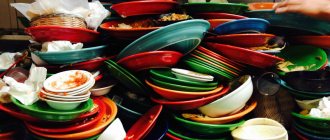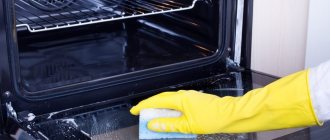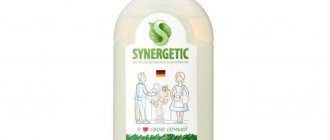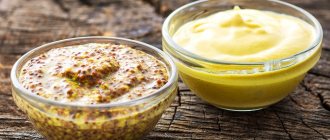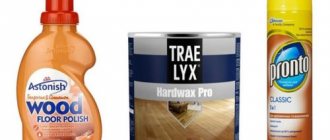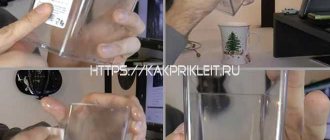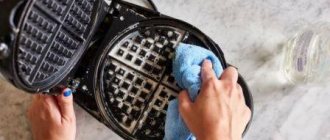Updated: 06/02/2021 11:19:31
Expert: Panteleeva Irina Vladimirovna
Today we will tell you how to turn washing dishes from a boring routine process into an exciting quest. You will learn how you can wash a mountain of dishes in 10 minutes and many interesting subtleties of this process.
After this article, you will become a clean plate expert and will create a dishwashing schedule so you don't miss your turn. To begin with, let’s select the appropriate tools and means.
How to speed up the process
The most banal advice: wash the dishes right away. This will eliminate the accumulation of dirty utensils and the need to remove dried-on food debris.
There are three tips that will help make the process of washing kitchen utensils easier.
- Get two sponges. Use one for washing cups and dishes from bread and fruit, the other for washing greasy dishes. Use sponges of different colors to avoid confusion. A sponge for greasy utensils needs to be changed more often than a sponge for cups.
- Salt will help get rid of carbon deposits on the pan. Just pour it into the bottom of the pan and leave it for a few hours. The contamination will fall away without any extra effort on your part.
- The soot will be washed off easier if you heat a frying pan over a fire and pour a glass of warm water into it.
What products will help you wash dishes quickly?
If due to some circumstances (allergy, reluctance to use “chemicals”) special detergents and cleaning products are not suitable for you, then you can always use folk remedies. They are absolutely safe for health, and the quality of washing is not inferior to store-bought products.
- A combination of baking soda and vinegar will help get rid of fat. If desired, vinegar is replaced with citric acid: the effect is the same, but the smell is favorably different.
- Mustard powder and soda ash will help out when you need to remove heavy dirt or grease.
- Laundry soap can also remove grease from cutlery. You can prepare a detergent: grate soap, add salt or water. To aromatize, add a drop of aromatic oil.
- Burnt milk will be removed by using an activated carbon tablet, thoroughly crushed beforehand.
- Sodium burate will help get rid of stubborn stains. You can buy it at the pharmacy. It is a natural antiseptic, which means it can not only clean dirt, but also kill germs.
- To make glass kitchen utensils and crystal products sparkle, ammonia will come to the rescue.
When resorting to these tips, do not forget that only cutlery without a non-stick coating can be washed with soda, otherwise it will be hopelessly damaged.
Washing kitchen utensils is an activity that you cannot escape. But with the help of our advice, the process will begin to go quickly and “painlessly”.
Many will be surprised, but you also need to be able to wash dishes correctly. Washing rules help to effectively deal with simple and complex stains. They minimize the risk of infection from infectious diseases, chemical and food poisoning. They also make the cleaning process simple and easy.
Top 5 common mistakes
What can you do wrong when doing basic washing of dishes? Here are the top 5 common mistakes:
- Too much detergent. The generous soul of a Russian person does not allow him to put just a drop on a sponge. The result is an excess of surfactants on “cleanly washed” dishes.
- Wash the pan from the inside only. Men often sin with this, trying to rationalize any activity. As a result, even a new frying pan gradually becomes covered with “armor” of soot on the outside.
- Lack of care for glassware. A familiar picture from films is a bartender polishing glasses with a rag. These guys know what they're doing! If you let the glass dry naturally after washing, it will leave traces of drops. Over time, they will turn into a layer of cloudy plaque.
- Using inappropriate equipment. Old rags instead of sponges, hard washcloths and patterned dish brushes - the list goes on. Anything tougher than a typical foam sponge should be used sparingly and only as a last resort. And materials that rot in a humid environment (cotton, for example) are completely prohibited.
- Scraping dried food. The dirty plate had already dried out - and then you remembered about it. Take your time and fill it with water to loosen anything stuck to it.
Rules
How to properly wash dishes by hand:
- Before washing, all containers must be cleared of food debris. They are thrown into the trash can or toilet. If you don't do this, food will get stuck in the pipe under the sink and cause a clog.
- You cannot wash dishes in bulk; they must be sorted. Greasy plates, pans and pots are washed separately and last. The first to clean are cups, glasses, cutlery, as well as practically clean plates with crumbs.
- Detergents should be used for cleaning. They help wash away stuck pieces of food, dissolve grease and stains.
- To save water, pour it into a large basin and add detergent.
- To save detergent, drop it onto a sponge and foam it. The drop is renewed when the foam stops appearing.
- It is recommended to wash dishes immediately after use. For complex stains, soaking for 8 hours with the addition of cleaning agents is allowed. Otherwise, bacteria actively multiply in leftover food.
- After cleaning in a soapy solution, kitchen utensils must be washed under running water until they are no longer slippery.
- At the final stage, all dishes and the sink are dried. It is best to use an electric dryer. But if it is not there, you can wipe the plates with a towel or place them on a special mesh rack
What to wash with?
Everything ingenious is simple! Indeed, a sponge and a piece of cloth are the two main tools for keeping dishes clean. A universal microfiber cloth, a material made from the finest polyester fibers, would be ideal for washing. Due to its structure, microfiber absorbs water as well as a sponge and more than regular fabric, but bacteria and other contaminants do not linger in it, which ensures hygienic cleaning.
Microfiber cleaning cloths dry very quickly, do not shed, and do not leave lint. Due to the rich palette of colors and shades, you can match them to the color scheme of the kitchen or choose bright colors for a good mood.
Stages
When washing dishes, it is important to maintain consistency. There are only 5 stages:
- Pre-cleaning.
- The washing up.
- Rinsing.
- Drying.
To remove pieces of food, it is best to use a wooden or silicone spatula. Metal objects may leave scratches on the cookware.
Equipment
To wash dishes by hand, you need the following equipment:
- latex gloves;
- foam sponge;
- metal sponge;
- brush.
Gloves protect the skin of your hands from drying out. A foam sponge can be used to remove soft dirt. It also effectively foams the detergent. A metal sponge is used to remove burnt-on pieces of food, and a brush is used to clean bottles, cans and other containers with a narrow bottom.
To wash dishes at home as quickly and comfortably as possible, you can acquire improved equipment:
- brush with detergent reservoir;
- silicone sponges;
- silicone gloves.
Expert opinion
Soloviev Pavel Viktorovich
Designer with many years of experience and experience.
The metal sponge should not be used to clean patterned cookware, coated pans, enamel bowls or pans.
Dishwashing detergents
What is the correct way to wash dishes? There are several options - good and bad.
- Detergents and cleaning products for dishes.
Household chemicals make washing dishes much easier. They dissolve grease and stains, are easy to use, and are economical to use. Some types of products contain substances that reduce the negative effects on the skin of the hands. The only negative is that they are difficult to wash off and can remain on the dishes.
Powders are used to remove hard dirt, gels are used to wash soft food debris.
Washing dishes is a daily chore that does not bring any pleasure, but such operations need to be done every day. It is necessary to clean not only plates and cups, but also pots and pans with residual fat.
A dishwasher helps solve the problem, but if you don’t have one, you have to spend a certain amount of time near the sink. From our article we will learn how to quickly wash dishes using improvised means.
Aids
In the modern world, where there is always a store with a large selection of goods nearby, the question of detergent does not arise. You just need to choose the right one. To do this, you need to determine how and what dishes you will wash.
For women, the question often arises: how to properly wash dishes by hand without damaging the skin of your hands. For this purpose, there are now special means that will not have an aggressive effect on the hands. They have also produced special cleaning gels for children that do not harm the body. To protect yourself as much as possible, you should look at the composition of the gel or powder; it’s good if it contains as many natural ingredients as possible.
Another question: what is better to use - gel or powder? Gel can be used to wash “delicate” surfaces without damaging them, but powder copes better with complex stains. In fact, it is best to have both and use them depending on the situation.
It’s good, of course, when you have a special detergent at home, but if you’ve run out of it and are too lazy to run for it, don’t have time, or are there other reasons getting in the way? There are numerous ways to deal with oily stains without it.
For porcelain and crystal, water should be no higher than 35 degrees
. A cold one will not be able to wash away dirt, and a warm one will ruin the fragile material. Do not put them in the dishwasher: they will spoil. Soap solution, shampoo, gel are well suited for washing. You can use a toothbrush to clean the ribbed surface.
For such thin and fragile items, the following products are well suited:
When cleaning crystal, there is no question of how to wipe the dishes after washing. It is recommended to wipe dishes made of thin materials dry with a soft cloth to avoid streaks.
Process optimization
There are several simple rules to speed up the process of cleaning cutlery from dirt:
Attention!
A kitchen designer
has started working on our website . You can get acquainted with it and design the kitchen of your dreams completely free of charge! A wardrobe designer can also be useful.
- Wash dishes immediately after eating. If you delay this procedure, the leftover food will stick to the plates, making it much more difficult to scrape them off. Each member of the household can wash their own cup or plate, but there is often a situation where mountains of dishes accumulate in the sink. There is a need to show solidarity on this issue.
- If there is no desire or lack of time, cutlery with food residues is soaked in a sink or in a special container along with detergent. In this case, food will not stick to the surfaces of the plates. Simply wipe them with a sponge and rinse in clean water.
- Avoid using cloths; it is better to use special kitchen sponges for washing. Foam products will save time and detergents. Do not wait until the sponges are completely worn out or absorb grease; replace them constantly. An aluminum brush will help remove stuck particles; this product allows you to deal with dried food faster than foam sponges.
- It is not advisable to stack plates in one pile, especially if cleaning will be carried out some time after eating. In this case, the food will stick to the bottom, so the housewife will have to wash both sides at once.
- Do not skimp on detergent, because it allows you to remove grease and other complex contaminants. Pour gel onto the surface of the sponge, lather and get to work.
- To speed up the process, pre-sort cutlery, place knives, forks, spoons in separate places, place mugs and plates separately. Cleaning in batches will save time.
- Don't leave taps on, save water. First, rub the surface of the plates, spoons, forks and frying pan with detergent, and only then start rinsing.
- Few people know how to quickly wash dishes in 5 minutes. For this, special cleaning powders or gels are used. Such products are effective in both hot and cold water.
How to wash the dishes if you're lazy? After all, this daily work bores many housewives. Turn the process into a game, try to wash the cutlery in a short time - “faster than yesterday.” This will improve your skills and save water.
How to wash children's dishes?
It is better to wash children's dishes separately from adult ones, this prevents bacteria from getting on them.
The baby requires increased safety, so there are several rules:
- Bottles and plates should be washed immediately after eating - this prevents the growth of bacteria;
- if the material from which the dishes are made allows, boil them;
- You also need to pour boiling water over gauze and a brush, which are used for washing children’s dishes;
- if the products are heavily soiled, you should use soda or laundry soap that does not contain surfactants or other additives;
- Sponges and detergents used to clean adult cutlery, plates, especially pots and pans, should never be used for baby bottles or bowls.
The nuances of cleaning dishes from dirt
We have looked at methods for optimizing the process, now let's look at the steps.
Soak
If there is no basin or other container, cutlery can be placed in the sink, but the drain hole must be blocked with a stopper. After this, take the required amount of water and add a cleaning agent.
Washing process
While soaking, apply a few drops of detergent to the sponge, squeeze it several times and wait until foam appears. Wipe the surface of the plates on both sides, and then send the dishes to the sink.
Carry out manipulations until all items are in the sink. Next, rinse the cutlery under a small stream of water.
Wipe cutlery with a dry towel or place to dry.
How to quickly wash dishes by hand if the pre-soaking was done in the sink? In this case, set the minimum water flow, wipe plates or other kitchen utensils with a sponge and detergent, and rinse with water. One by one, the items are put to drying.
First, wash the plates, cups and other cutlery, then start cleaning the baking sheets, pans and pots.
How to make the washing process quick and enjoyable?
To make washing a large amount of dishes less tiring, you should follow a few tips:
- Take beautiful sponges, brushes, brushes, and a product with your favorite scent. Cheerful, bright colors lift your spirits, and a pleasant aroma sets you up for positive thoughts;
- "Eat the elephant one piece at a time." This phrase applies to many areas of life and actions, including the washing process. Here it works like this: lather the sponge well, wash the products with it until the foam runs out. After this, take a break for 10-15 minutes. This is a psychological technique that will help you wash even a large mountain of dishes without getting too tired;
- Use rubber gloves. They will serve as protection for the delicate skin of your hands; after washing you will not have to suffer from dryness or the appearance of hangnails;
- Wash plates, mugs, and cutlery immediately after eating. Thus, a huge mountain will not appear in the sink, which will take more than an hour to wash;
- Make the process as enjoyable and interesting as possible - listen to music, a podcast, watch a movie or TV series. This will help you spend time not only fun, but also useful;
- Relax. In the constant bustle, it is hardly possible to find a minute to be alone with yourself. Repeated movements are great for forgetting about problems, relaxing, they calm you down, and help you to abstract yourself.
Homemade Cleaning Remedies
Dishwashing solutions bought in a store often raise suspicions about the naturalness of the composition, because they will be applied to dishes containing food. Unnatural ingredients will enter the human stomach and can cause various disorders.
Therefore, some housewives prefer to use natural products to clean dishes. These are:
- Table salt allows you to quickly clear carbon deposits from the bottom of the pan. 150 grams of salt are evenly distributed in a bowl and left for several hours. The salt will corrode the carbon deposits and will quickly wash off. It is better to clean cast iron products immediately, as this material retains heat for a long time. Add salt immediately after removing the pan from the heat. This method is not used for treating glass surfaces; after such exposure, scratches may remain on them.
To quickly and effectively wash dishes while camping, use wood ash. You can use grass instead of a sponge.
Practical recommendations
To speed up the dishwashing process, use the following tips:
- Wipe tea utensils and crystal products with a dry cloth;
- Clean porcelain saucers and cups with gilding from dirt with a solution of laundry soap. The soda solution will help remove deposits on such products.
- To clean decorative glassware with narrow necks, crushed eggshells or pieces of paper are poured inside along with detergent.
- Grease stains on glass surfaces can be removed using an alcohol solution (60 grams of active substance per liter of water).
The baking sheets are covered with baking soda or a special cleaning powder, then washed off with water and wiped dry with a cloth. Everyone can quickly wash any dishes, the main thing is to choose the right detergents for a specific type of product.
Subtleties of cleaning kitchen utensils
Now all that remains is to wash the items that were used for cooking. In this case, the following nuances must be taken into account:
- Copper and cast iron products that are burnt and covered with a layer of fat are cleaned with gel and then with soda using a steel wool. The washed one is additionally calcined and lubricated with vegetable oil.
- wash only with soda or mustard powder without abrasives. If there is a dark residue left in the pan after cooking the beets, boil potato or apple peels in it for an hour.
- Aluminum, on the contrary, does not tolerate contact with soda. It is tidied up with a soft sponge soaked in an aqueous solution of borax and ammonia (30 g: 10 g per 1 l). The pan is covered with the mixture for half an hour, and then wiped with a dry cloth and washed in several waters.
- All parts of the meat grinder are thoroughly washed, and the grate holes are cleaned with a match. The grater is cleaned with a steel wool and then poured with boiling water.
- Wooden cutting boards are soaped with soap (soda will darken them), and then scraped with a knife and doused with boiling water. Plastic is cleaned with soda. If fish was cut on a board, first rub it with half an onion.
Wash dishes correctly
It is difficult to find a housewife who would declare with a sparkle in her eyes that she loves washing dishes. Nevertheless, proper care of dishes is one of the keys to your health and cleanliness in the apartment. And if you haven't purchased a dishwasher, you have to wash the dishes by hand.
Historical reference
“The Queen of Detectives” Agatha Christie, when asked where she gets the plots for her novels, always answered: “The best ideas come to me when I start washing the dishes. This is such a boring and thankless task that thoughts of murder arise on their own.”
Now trade offers a wide range of different tools for this work. However, many housewives prefer a proven remedy - dry mustard (1 tbsp per glass of water). It has a degreasing effect even in cold water.
It should be remembered that under no circumstances should you use washing powders for washing dishes. It has been established that even after prolonged rinsing, surfactants remain on it, harmful to the human body.
Caring for dishes is not an easy and not very pleasant job, especially for the skin of our hands, so rubber gloves are needed to protect our hands from exposure to grease, hot water, and detergents. Special long-handled brushes for cleaning and washing dishes provide good protection for your hands.
You need to start washing dishes with the least dirty ones, for example, teaspoons and saucers, and finish with the greasy plates and pans. At the same time, washing greasy dishes will be made easier by the good habit of not stacking them.
It is not recommended to dry clean dishes with a towel; it is better to dry them in the dryer.
How to properly wash metal utensils
Before washing, cast iron pans should be wiped with paper and then washed with hot water and soap. If the food is slightly burnt, you need to slightly heat the frying pan and wipe it with salt and then with parchment (or, in extreme cases, plain paper). To make an iron frying pan shine after washing, you can rub it with hot salt.
Expert opinion
Soloviev Pavel Viktorovich
Designer with many years of experience and experience.
Enameled cookware is very convenient due to its resistance to salts and acids that make up food. The disadvantage of such cookware is that the enamel is unstable to impacts and sudden temperature changes.
The enamel cracks and chips form. Cookware with internal damage to the enamel should not be used for cooking.
because at the slightest blow, the enamel continues to deteriorate, its particles can get into food and cause harm to health.
Enameled dishes cannot be scraped with a metal brush; they should be washed with hot water and detergent or baking soda. Do not cook porridge in enamel dishes, as they will burn in it.
If burnt food remains are not washed off immediately, pour cold water into the pan, add a handful of salt (or soda) and leave for several hours.
Darkened enamel pans should be boiled with any dishwashing liquid and then rinsed with hot water. But if you boil them with a vinegar solution twice a month, they will not darken.
Aluminum pans are lightweight, do not rust, are not afraid of sudden temperature fluctuations, are easy to clean, but are spoiled by salt, soda and acids, so you should not cook cabbage soup from sauerkraut, sorrel, compotes, or jelly in them. You cannot store prepared food in it either.
Aluminum cookware should not be cleaned from the inside with preparations containing abrasive materials that destroy the protective film. For the same reason, do not use wire wool.
Products with high alkalinity, such as soda ash, are also unsuitable. Wash such dishes with a soft washcloth in hot water with soap or baking soda.
And if you boil it with potato peelings, apple peels, rhubarb peels or a vinegar solution, aluminum cookware will shine like new.
Silver and nickel plated dishes are washed with warm soapy water. You can clean it well with chalk and ammonia - apply the solution and let it dry, then rinse with water and wipe dry.
To clean heavily soiled silverware from old grease and dirt, it should first be baked in the oven. After this, the dishes are boiled in a solution of 25 g of table salt in 400 ml of water.
Silver can be restored to its lost shine by immersing it in potato broth for 10 minutes or boiling it in a concentrated broth of garlic peels.
Once a week, silver spoons should be washed in soapy water with a small amount of ammonia. And so that they always shine, immediately after use, immerse them in boiling water to which a small amount of soda has been added.
Dark stains formed on silver from egg yolks can be removed by wiping the spoon with cigarette ash. Damp stains disappear by washing silver in warm vinegar.
It is good to clean copper and brass items with this simple composition: 25 g of table salt and 1 glass of whey (200 ml). Soak a soft cloth with the resulting mixture and lubricate the surface of the object. Then you need to rinse it with water and wipe it with a dry cloth until it shines like a mirror.
Iron sheets, molds and baking sheets are processed as follows. Remove dirt and rust from them using ash, emery or coarse salt.
Expert opinion
Soloviev Pavel Viktorovich
Designer with many years of experience and experience.
Also, rusty iron baking sheets can be easily cleaned with raw potatoes and fine river sand. Then they are washed, dried, coated with a thin layer of vegetable oil and heated in a hot (at least 200°) oven until the smoke disappears.
After this, a thin fatty film forms on the sheets, protecting them from rust. Please note that if the sheet is not heated enough, your fingers will stick to it, and if you overheat it, the protective layer will come off the sheet.
Baked goods will not stick to a properly processed sheet. After use, baking trays and sheets should be washed and stored in a dry place.
To remove burnt food, sprinkle the dishes generously with salt or soda, fill with warm water and leave for several hours. For severe contamination, pour water with mustard or baking soda and boil.
Then wash with a soft sponge or brush. You should not use steel wool or brushes or scrape off soot or burnt-on food debris.
To remove scale, pour water into a metal kettle, bring it to a boil, add baking soda (2-2.5 tbsp.
per 1 liter of water) and boil for 20-25 minutes. After draining the water, pour in a solution of vinegar essence (0.5 cup per 4 liters of water) and boil again for 20-30 minutes.
The scale will become loose and you can easily scrape it off. Then the kettle must be thoroughly rinsed with clean water.
How to properly wash ceramic dishes
It is better to wash ceramic dishes with hot water and baking soda, then rinse with clean water. Unglazed clay dishes must be thoroughly dried.
Clay products last longer if before use they are placed in cold water for several hours and then rinsed in hot water. Even better, fill the earthenware pot to the brim with cold water, put it on the fire and, after heating, slowly cool it. The fragile glaze is thus strengthened.
► Expert advice. If suddenly a crack appears in the pottery, it can be easily repaired. Several lumps of sugar are melted into syrup, poured into a cracked bowl and heated over a fire.
Flowing into all the cracks, the syrup gradually dries out, darkens, forming a mass as solid as the vessel itself. A vessel filled with such a mass is suitable for use for a long time.
Glazed pottery has a certain value and beauty. It is used both for interior decoration and for household purposes in the kitchen. Before use, glazed dishes should be boiled in water for half an hour, adding 1 glass of vinegar and 2 tbsp. l. salt.
Expert opinion
Soloviev Pavel Viktorovich
Designer with many years of experience and experience.
Pottery should always be kept open. Covered with a lid, it acquires an unpleasant odor. Remove it by repeated rinsing with cold water.
How to wash earthenware and porcelain dishes
Earthenware should be washed with warm water and soap. If the water is too hot, the glaze covering it will crack. In order to return the whiteness of porcelain dishes (after prolonged use they darken), they are wiped with baking soda or salt.
Porcelain dishes must be handled with care. After prolonged use, it darkens and loses its original appearance.
To return porcelain to its whiteness and freshness, you need to wipe it with baking soda, salt and vinegar, or a piece of cloth soaked in turpentine. Individual stains on expensive porcelain items can be removed by wiping them with water with the addition of a small amount of ammonia.
The water should not be hot so as not to damage the design.
Porcelain plates that are used infrequently are well preserved if they are lined with white paper.
How to wash glassware
Glassware and crystal dishes are washed in warm salt water. Please note that hot water makes the glass dull. To add shine, rinse with cold water and add a little blue or vinegar. You can use water infused with lemon peel for rinsing.
To prevent the glass jar from bursting when hot foods (jam, preserves, etc.) are poured into it, you must place a damp cloth under the container.
New glass glasses and glasses will not break easily if they are placed in a vessel of cold water, slowly heated to a boil and left to cool in the same water.
Fireproof glass cookware will last a very long time if handled correctly. Food does not burn in such dishes.
But when cooking food, the bottom should always be covered with a layer of liquid or fat. Heat food in it over low heat with constant stirring.
Do not pour cold liquid into a hot fireproof dish, as this may cause it to burst, and you should also not place dishes with a wet bottom on the stove. Do not rub refractory cookware with wire or sand, as this will damage it.
Little tricks
You can clean a coffee pot from a thin brown coating by boiling water with a slice of lemon in it. You can also remove stains from tea and coffee by wiping the cup with table vinegar or a strong solution of table salt.
Dishes containing milk should be washed first with cold and then hot water, and those containing dough or mixtures with eggs should be washed vice versa.
Plastic products are washed with cold water. Modern detergents do an excellent job of this.
Wooden dishes easily absorb unpleasant odors. To remove it, the dishes need to be wiped with warm vodka or washed with hot water with the addition of vinegar.
It is not recommended to wash knives with hot water. Avoid leaving knives on a hot stove, as steel loses its strength and elasticity when heated.
Knives should be kept separate from other metal objects (forks, spoons), when in contact with which they quickly become dull. But if you hold the knife in a weak solution of table salt for 30 minutes, it can be easily sharpened (without wiping).
Metal baking foil will last much longer in the refrigerator - it does not stick together there.
Cutting boards that have absorbed the smell of onions, meat, or fish should always be washed with cold water (it removes odors better than hot water). Mustard powder or vinegar helps get rid of particularly persistent odors.
The smell of fish or onions in frying pans and pots will disappear if you wipe them with heated salt or damp, drunk tea, and then rinse.
If spoons and forks have a fishy smell, you need to wash them with cold soapy water, lubricate them with vegetable oil and dry them gently with a soft towel.
To prevent your hands from smelling like onions, wipe them with chopped parsley. To prevent your hands from smelling like garlic, wipe them with chopped celery.
The smell of onions during cooking can be removed by rubbing kitchen boards and cutlery with dry salt.
You can get rid of an unpleasant smell in the kitchen by boiling water with vinegar in an open container and ventilating the room after a few minutes. For the same purpose, you can put an orange or lemon peel on a heated burner or sprinkle a little salt on a hot stove.
Peeling potatoes darkens the skin on your hands. To avoid this, you need to wet your hands with vinegar before work and let them dry, and after work, immediately wash them with soap and lubricate them with cream.
If you forgot to do this in advance and your hands are stained from working in the kitchen, wipe them with an apple peel. You can also wet your hands with a weak solution of vinegar or a very weak solution of ammonia, and then wash.
Not all housewives trust dishwashers, preferring to do not the most pleasant household chores manually. If you know how to wash dishes, taking into account some of the nuances, you can not only get a high-quality result, but also reduce the hassle to a minimum.
Expert opinion
Soloviev Pavel Viktorovich
Designer with many years of experience and experience.
First of all, you need to spend a few minutes preparing for the manipulation. An equally important point is the pre-processing of products.
The rules for washing dishes are very simple, but only a few adhere to them.
- How to organize the process correctly?
- Recommendations for washing metal products
- Features of ceramic processing
- What is the best way to wash earthenware, porcelain and glass?
Procedure
To learn how to quickly wash dishes, you need, as we have already said, to wash them immediately when they get dirty. If this is not possible, dirty dishes should be cleaned of waste and filled with warm water, preferably with the addition of a small amount of detergent. This can be done either in a large basin or directly in the kitchen sink, after closing the drain.
If you need to find out how to wash dishes if there is no hot water, the answer is simple: since it is unlikely to be possible to wash greasy dishes with cold water, you can heat the water in a kettle, pour it over the dishes, and then soap them. And rinse off with cold running water.
Step-by-step instructions and recommendations for washing dishes
You shouldn’t wash dishes “at random” - it’s better to divide them into categories and wash them according to the degree of contamination. It usually looks like this:
- Glasses and cups. They are washed first, since they are rarely very dirty - in most cases it is enough to treat them with a sponge and hot water - this is the case when you can wash the dishes without detergents.
- Boards for cutting food. If raw fruits, vegetables, or bread were cut into them, just rinse them. Cheese, meat, fish, fried or baked vegetables in oil will have to be washed.
- Cutlery - spoons, forks, knives, spatulas. These are small items, freeing the sink from which will make it easier to maneuver larger dishes. Here you will need detergent.
- Dishes. Washing them usually takes some effort.
- Cooking utensils - bowls, pots, saucepans, frying pans, baking sheets, other utensils. The dirtiest dishes and the most labor-intensive stage of work. Here, sometimes you have to resort to additional “artillery” - scrapers, more aggressive detergents.
If there are really a lot of dishes, you can wash them in groups - either according to those given above, or using the “one sponge principle” - wash as much as one soapy sponge will last, then take a break and wash as much as the next soapy sponge will last.
How to organize the process correctly?
Housewives are often interested in how to quickly wash dishes, spending a minimum of effort. The most unusual approaches are used - from soaking to treating plates with a watering hose.
All this looks impressive, but it does not provide advantages, but additional troubles. In order to wash plates and other containers from grease and dirty stains in the shortest possible time, you just need to organize everything correctly.
The preparatory stage should look something like this:
- We prepare everything you need. These are not only household chemicals and sponges. Be sure to use an apron, gloves, and put pipe cleaners and brushes within easy reach. We spread a towel on which we will place clean dishes.
- If there is no hot water in the house, it needs to be heated. Modern products and natural reagents do an excellent job of removing traces of grease and even old dense plaque, but the use of hot water greatly improves the quality of processing materials.
Advice: It’s not enough to know how to wash dishes correctly, you also need to process them properly afterwards. You should not dry clean items with a towel; it is better to use a dryer or simply lay the items on a waffle towel. This will prevent streaks and scratches from appearing on the material.
- It is strictly forbidden to collect dirty dishes in a stack, no matter how much space this saves. As a last resort, in the process of storing dishes like this, you need to use polyethylene as a protective layer.
- Contrary to popular belief, you should wash less soiled items first. Only after this can you try to wash pots, bowls and frying pans from serious dirt and grease.
If you don't take care of everything from the beginning, washing dishes can leave your entire kitchen dirty. Because of this, you will also have to spend time getting the room in order.
Complex contaminants
It’s good if everything is washed on the same day, but what to do with old stains, how to get rid of them. There are several secrets here too.
If you know some tricks and use them, then washing dishes will no longer be so long and scary. Use these tips to learn how to quickly wash dishes and make your life easier.
Attention, TODAY only!
In the 21st century, the pace of life has increased so much that we, immersed in endless daily worries, do not have time to be with our family, do our favorite things, or do what we had planned a long time ago.
But, unfortunately, there is no escape from everyday chores, and you have to deal with them day after day.
However, there is a great way to save time on household chores, namely, to increase the efficiency of their implementation. In fact, ordinary things can be done much faster and even more interesting.
For example, washing dishes often takes a significant amount of time and this process is always associated with negative emotions. I have to force myself to go to the kitchen to empty the sink. However, this procedure can be accelerated.
Let's look at ways to optimize the dishwashing process:
- Wash dishes immediately after eating. It is easier to wash off food residues before they dry onto the dishes. Yes, sometimes it’s difficult to force yourself to wash the dishes right away, however, if you develop such a habit, which turns into a need, you will not only increase the speed of washing dishes, but there will never be unwashed dishes in the house, as well as the burden of what else -it's not done.
- Soak the dishes. If you still can’t wash the dishes right away, fill them with warm water. This will prevent the dirt from drying.
- Use dishwashing facilities. Now, as before, many people use a cloth, but it is much more convenient to use a sponge. For dishes, it is better to use large sponges and change them without waiting until they are completely worn out. A new sponge makes washing dishes faster, more convenient and more enjoyable. If necessary, use iron sponges (when the dirt is ingrained) - this will save your effort and time. Unfortunately, iron sponges are not applicable to all dishes.
- Don't stack plates on plates. It will be easier for you to wash the plate from below.
- Don't skimp on the detergent. Pour more onto the sponge. Dirt will be washed off faster, there will also be a lot of foam and washing will become much more enjoyable. Don't save money on dishwashing liquid - it's not a big savings. Better save time - it is known to be more valuable than money.
- Sort your dishes. Wash spoons, forks, knives first, then cups, then plates, and finally pots and pans. For what? Practice shows that by doing this you save time. Instant muscle memory allows you to wash the same type of dishes faster, but this doesn't work if you jump from one type of dish to another. Moreover, this sequence allows you to maintain order while washing dishes.
- Always learn. Every time you wash dishes, keep in your head the thought that you can wash even faster. Try. Over time, your skill will increase and your dishwashing time will decrease.
Now all that remains is to decide what to do pleasantly with the time freed from dishes!
Washing dishes is a chore that few people enjoy, but it is often inevitable. You have to wash dishes several times a day: one plate or set, a cup after tea and a greasy frying pan after frying meat. If there is no dishwasher, this process is so unloved that some people even stop receiving guests - after all, after their visit, the amount of dirty dishes increases.
It is especially difficult to wash after dinner, when an eventful day has passed, and of all the desires there is only one thing left: to rest as soon as possible. This household chore won't ruin your mood so much if you learn how to quickly wash the dishes. Just a few days you need to remind yourself of the new recommendations, and soon doing it correctly will become a habit.
A dishwasher makes life easier, but it is not a panacea. Rule one and most important: do not accumulate dishes during the day. With this approach, by the time of washing, a really large volume will accumulate, which will not be able to be overcome immediately. In addition, a dirty plate set aside on one side of the sink, cups on the other, pots and saucepans inside it will spoil the mood every time you visit the kitchen. And this is not to mention the fact that food remains dry out, and the longer they remain, the more difficult it is to remove them later.
It is better to wash dishes as they accumulate. Moreover, small volumes are easy to handle, even while water for tea is heating up or soup is boiling.
All family members should be taught to throw leftover food from their plates into the trash can, and put the dirty dishes themselves in one place - this way you won’t have to take a sightseeing tour of the house looking for a missing cup or spoon. And the amount of work will be visible immediately, without unpleasant surprises, when you already want to breathe a sigh of relief, but suddenly your gaze falls on a forgotten bowl at the other end of the kitchen.
Note: After eating, you should not put plates in one pile: in this case, the bottom of each plate, except the very bottom one, will be dirty, greasy, and much more difficult to clean.
Some household professionals recommend having two sponges - one for lightly soiled dishes, the other for greasy ones. To make it more convenient, you should choose sponges of different sizes or colors.
It is advisable to purchase several sponges: soft for removing grease and hard for dried dirt and burnt marks.
Rubber gloves are one of the most important dishwashing attributes for some housewives. Indeed, they perfectly protect the skin of the hands from the effects of water, which can dry it out and cause rapid aging of the skin. But this attribute is not suitable for everyone: some are accustomed to washing dishes with their bare hands and can determine by touch how well the grease has been removed from the surface of glass, porcelain or ceramics.
Recommendations for washing metal products
If you have to wash dishes made not from the same material, but from different ones, you should spend a few minutes and sort the items. This technique will help determine the scope of work, determine the household chemicals, water temperature and type of tools used.
For example, metal products are quite demanding and capricious. To wash them from dirt and old grease, you need to consider the following recommendations:
- Cast iron. Practice shows that few people know how to properly wash dishes made from this raw material. First, the surface of the object must be rubbed with paper, after which you can begin washing using hot water and soap. Burnt food is rubbed off with salt.
- Enamel. If these items have to be washed by hand, it is necessary to exclude temperature changes and aggressive mechanical influence. Therefore, we abandon metal scourers and plastic brushes in favor of hot water with detergent or baking soda.
- Darkened enamel. No amount of chemistry can cope with this problem, so you need to initially approach its solution correctly. You just need to pour water with detergent diluted in it into the damaged container and bring this mixture to a boil.
- Aluminum. In this case, it is prohibited to use salt, acids or soda, abrasive products, or wire wool for cleaning. To wash the container, you need to gently rub it with a sponge dipped in soapy water. Boiling a weak solution of vinegar or water with potato peelings in a bowl will restore its shine.
- Silver and nickel. We use warm water, neutral detergents and as soft as possible. Few people know that these products can be easily cleaned with chalk and ammonia. Apply the prepared solution to problem areas and wash it off with water when it dries. Only if you know how to properly wash dishes made from such capricious materials can you count on their long service life and maintaining an attractive appearance. Even if the silver is not covered with grease stains, it should be washed regularly with soapy water and a couple of drops of ammonia.
- Copper and brass. If household chemicals do not help, you should mix a tablespoon of salt and a glass of whey. We wet a sponge or soft cloth in the solution and carefully wipe off the dirt from the material.
- Iron. Baking trays or baking dishes are difficult to quickly wash by hand and require soaking. As a last resort, if time is running out, you should try options using emery, river sand, ash or potato slices.
To remove burnt-on plaque, it is not necessary to use various household chemicals; it is enough to soak the product in a solution made from salt and water. If the contamination is very strong, then a little more mustard powder should be added to the liquid.
Algorithm of actions, or faster
The following sequence of actions will allow you to quickly wash dishes by hand:
- First of all, cups and glasses are washed in warm water. To do this, use industrial gel, soda or laundry soap. The embossed surfaces are cleaned with a toothbrush, drips and dark deposits from tea and coffee are removed with soda slurry, salt or a weak solution of vinegar.
- Using the same cleaners, low-fat tea utensils and dessert containers are tidied up.
- Jars and bowls of dairy products, dough and flour are first rinsed with cold water and then hot.
- Next, you should wash the cutlery. Stainless steel is washed as usual. and silver is cleaned with a soap solution to which a few drops of ammonia are added.
- After this, they move on to salad bowls, gravy boats and dinner plates, starting with less fatty items. If there were very fatty dishes in the dishes, in order to remove the smell and film, it is additionally washed with soda. You can properly clean dishes from grease only in hot water.
Since plastic and artistic coatings (for example: Gzhel) cannot withstand high temperatures, it is better not to serve main courses in them.
- Lastly, wash the dishes and plates in which the fish was placed. They are oiled and then cleaned with detergent.
- All washed dishes are rinsed additionally. Glass, crystal and porcelain - with cold water, preferably with the addition of vinegar or salt. Clay and earthenware - hot.
- Clean dishes are placed in the dryer on their edges. If it is not there, plates and glasses are dried on a horizontal surface upside down.
